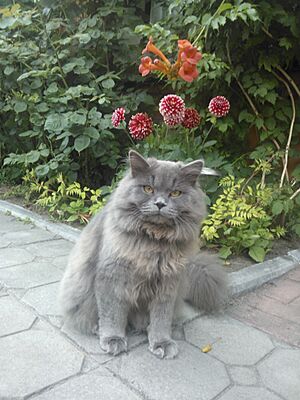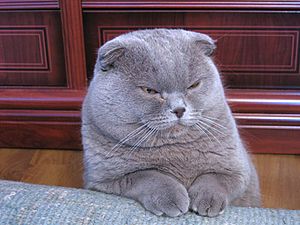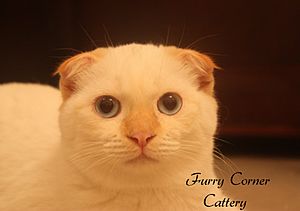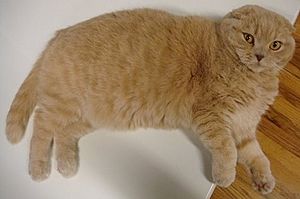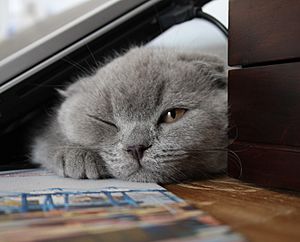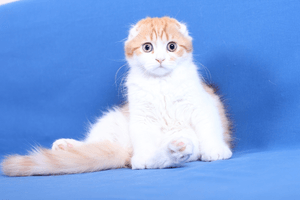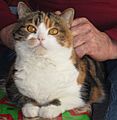Scottish Fold facts for kids
Quick facts for kids Scottish Fold |
|
|---|---|
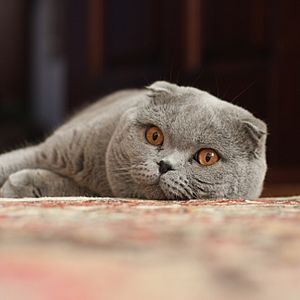
A Scottish Fold cat with lilac fur, showing its round face, round eyes, and folded ears.
|
|
| Other names | Scot Fold |
| Origin | Scotland |
| Domestic cat (Felis catus) | |
The Scottish Fold is a special type of cat. It is sometimes called Coupari by cat breeders in Canada. These cats are famous for their unique ears that fold forward. This special ear shape is caused by a specific gene that the cats inherit.
At first, these cats were called Flops because of their "floppy" ears. But in 1966, the name was changed to Scottish Fold. If a Scottish Fold has long hair, it might be called by different names. For example, some people call them Highland Fold, while others call them Scottish Fold Longhair.
Contents
About the Scottish Fold Breed
Where Did Scottish Folds Come From?
The very first Scottish Fold was a long-haired barn cat named Susie. She had white fur and was found in 1961 on a farm in Scotland. Susie's ears had a very unusual fold in the middle, which made her look a bit like an owl.
When Susie had kittens, two of them were born with the same special folded ears. A farmer and cat-lover named William Ross owned one of these kittens. Mr. Ross decided to register this new type of cat. He started a breeding program with the help of Pat Turner to create more Scottish Fold kittens. In the first three years, they had 76 kittens, and 42 of them had folded ears. They learned that the folded ear trait was caused by a strong gene. This means that if one parent has folded ears, about half of the kittens will also have folded ears.
Susie had only one kitten that could have babies, a female Fold named Snooks. Snooks was also white, just like her mother. Sadly, Susie was hit by a car and died three months after Snooks was born. All Scottish Fold cats alive today are related to Susie and Snooks. This kind of family tree is very rare for purebred animals.
How the Breed Became Popular
At first, the Scottish Fold breed was not allowed in cat shows in Great Britain and Europe. People worried that these cats might have a lot of ear problems, like infections or mites, or even deafness. However, Scottish Folds were sold in America. The breed continued to grow by being bred with British Shorthairs and American Shorthairs. Even though people were worried, Scottish Folds have not had more ear problems than other cats. But, wax can build up in their ears faster than in cats with straight ears.
Scottish Folds are very popular pets. People love their unique look and their reputation as loving companions. Because they are so special, Scottish Fold kittens are usually more expensive than kittens of other common cat breeds.
What Makes a Scottish Fold Special?
Their Unique Ears
All Scottish Fold kittens are born with straight ears. If a kitten has the Fold gene, its ears will start to fold forward before it is 21 days old. The first Scottish Folds only had one fold in their ears. But over time, breeders have worked to create cats with a double or even triple fold. This makes the ear lie very flat against the head.
The folded ears are caused by a gene that changes the cartilage in their ears. This makes the ears fold forward and down, making their head look like it has a little cap. Cats with smaller, tightly folded ears are usually preferred. Even with folded ears, these cats still use their ears to show how they feel. Their ears can swivel to listen, lay back when they are angry, and perk up when they hear a treat bag!
Body Shape and Size
Scottish Folds are medium-sized cats. Males usually weigh between 9 and 13 pounds, and females weigh between 6 and 9 pounds. They have round bodies, round heads, and round faces. Their eyes are large and round, and their noses are short with a gentle curve. They have medium to short legs and very short necks. The wide space between their eyes gives the Scottish Fold a "sweet expression."
Coat Colors and Patterns
Scottish Folds can have either long or short hair. They come in almost any coat color or mix of colors, including white. The only colors they don't usually have are "pointed" colors (like Siamese cats).
Scottish Fold cats can have many different coat types. Some have solid colors like white, black, blue, red, or cream. Others have silver or golden fur. There are also "smoke" cats, which can be black, blue, or cameo. Many Scottish Folds have tabby patterns, which can be classic, mackerel, spotted, or ticked. These tabby cats can be silver, blue-silver, red, brown, blue, cream, or cameo. You can also find Scottish Folds with tortoiseshell, calico, or bi-color patterns.
Personality and Social Behavior
Scottish Folds, whether their ears are folded or straight, are usually good-natured and calm. They can easily get along with other animals in a home. They often become very close to their human families and are naturally loving. People often say that Folds are playful, affectionate, and good at grooming themselves. They are also known for being clever, loyal, quiet, and good at adapting to new home situations.
Unique Habits
Scottish Folds are also known for sleeping on their backs. They usually have soft voices and can make a mix of meows and purrs that sound different from other cat breeds.
Health and Breeding
How Long Do Scottish Folds Live?
Scottish Folds typically live for about 15 years.
Common Health Issues
Scottish Folds can sometimes get certain health problems. These include polycystic kidney disease (PKD), a bone and cartilage problem called osteochondritis, and a heart condition called cardiomyopathy.
Breeding and Kittens
Since a Fold kitten's ears don't fold until almost a month after birth, breeders have to wait to see if the ears will fold. This means it's hard to know right away how many folded-ear kittens are in a litter. As the website PetFinder.com explains: "All Folds are born with straight ears. At around three weeks the ears begin to fold, if they are going to. Since it's not readily apparent how many Folds one has, breeders must play a waiting game until the ears develop their final folds. Even then it's difficult to tell if the folds will be the tight folds preferred in the show ring or the looser, pet-quality folds."
Ethical Breeding Practices
There is a special health concern if both parent cats have folded ears. If two folded-ear cats are bred together, their kittens are very likely (about 1 in 4) to get a painful joint disease. This disease can cause their tail, ankles, or knees to become stiff. Scientists believe this disease is caused by the dominant gene that creates the folded ears. It is more likely to affect cats that have two copies of this gene. This disease can also affect Scottish Folds with only one copy of the gene, but usually not as often or as severely.
Because of this risk, the breed is not accepted by some cat organizations, like the Governing Council of the Cat Fancy in Great Britain. This is why many people believe that the only responsible way to breed Scottish Folds is to breed a folded-ear cat with a straight-eared cat, and never two folded-ear cats together. This is similar to how Munchkin cats are bred.
Scottish Folds in Books
Stories About Scottish Folds
The Scottish Fold is a main character in the short novel The Cat Who Went to Paris by Peter Gethers. This book and its two follow-ups, A Cat Abroad and The Cat Who'll Live Forever: The Final Adventures of Norton, the Perfect Cat, and His Imperfect Human, tell the story of Gethers and his Scottish Fold cat, Norton. The books cover their first meeting all the way to Norton's death and Gethers' life afterward.
Guides for Owners
You can find many guidebooks about the Scottish Fold breed. Some examples include Scottish Fold Cats: A Complete Pet Owner's Manual, Guide to Owning a Scottish Fold Cat, and Scottish Fold Cats (Cats Set III). These books can help you learn how to care for a Scottish Fold.
Images for kids
See also
 In Spanish: Scottish Fold para niños
In Spanish: Scottish Fold para niños


